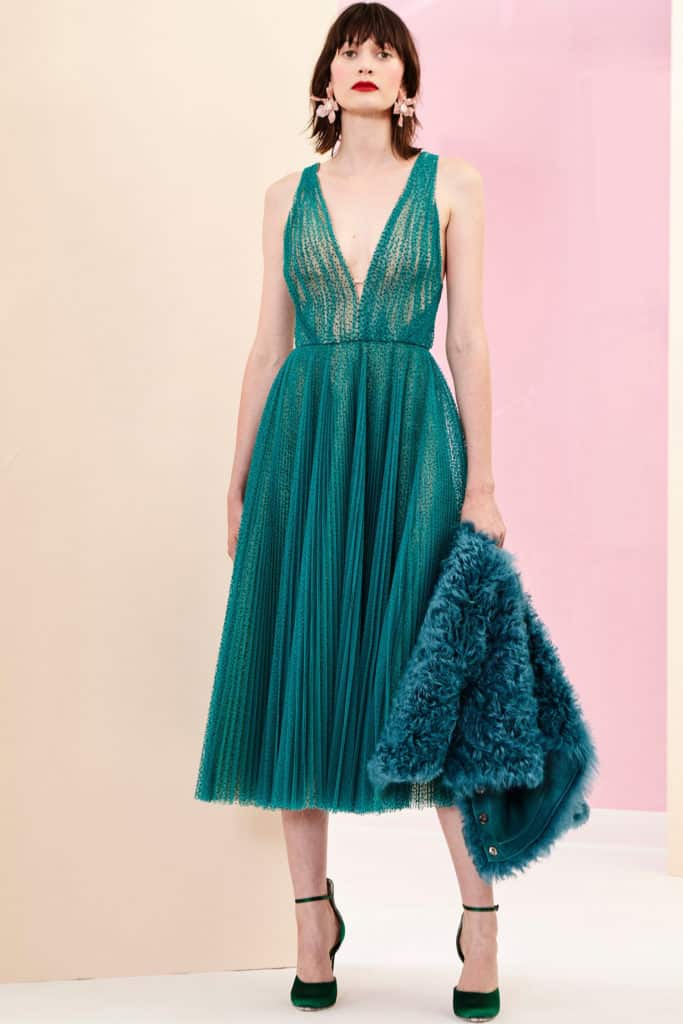
Classic, sophisticated, feminine: J. Mendel is go-to fashion for our topsy-turvy times – and for us here at Mary Jane Denzer, who have long featured the house’s shimmering, ladylike creations.
“People are trying to save the planet, and they are becoming more aware of their surroundings,” CEO and creative director Gilles Mendel told Vogue. “In clothing [that translates into] an idea of being more conscious of what you wear.”
And what you wear being sustainable not only environmentally but sartorially. Here’s Vogue on what Mendel brings to this concept in his Fall Collection: “Manipulation of materials is the bedrock of Mendel’s practice, and for Fall it was evident in a red mille-feuille pleated dress with an asymmetric ruffle neckline and a confectionery pink princess dress; keepers, both….The best of (the line’s younger looks) were ruffled dresses of lovely lace in a sort of super-lady Batsheva mode and beaded knit openwork tunics; think of them as the dressed-up-lady equivalent of the holey T-shirt.”
Vogue was even more enthusiastic about Mendel’s Spring Ready-to-Wear Collection, inspired by the transparency and intricacy of Venetian glass. (Giles’ father, Jacques, whom he succeeded at the company’s helm in 1981, was a Venetian glass collector.) White lace and print dresses, a white mesh-patterned tulle embellished with cord and beads, a pink pleated dress wrapped in a gigantic bow at its empire waist: These spoke of the collection’s lucent theme. But, Vogue noted, “The purest expression of Mendel’s craft, and most resonant with his Venetian theme, was a black dress with beaded horsehair appliqués topped by a cape bolero that would be the belle of any ball.”
The key word in that sentence may be “horsehair,” for J. Mendel did not begin life as a fashion house but as a furrier in 1870 St. Petersburg, Russia, where Joseph Mendel – the original “J” in J. Mendel – operated under the principles of quality, craftsmanship, luxury and style. Five years later, he was commissioned to create an ermine cape for Czar Alexander II’s wife, the Czarina Maria Alexandrovna, which began the Mendel association with the Romanov dynasty as its official furrier. In 1918, that dynasty came to an end as its last ruler, Czar Nicholas II, his wife, Alexandra, and their five children were assassinated following the Russian Revolution. Two years later, Jacques Mendel moved to Paris – which would be home in the 1920s to many creative Russian expatriates like Ballets Russes founder Serge Diaghilev and choreographer George Balanchine – and went to work for the house of Révillion.
There in the City of Light, Jacques opened the first Mendel fur atelier in 1934. It was relocated in 1970 to the Rue Saint-Honoré, home of the first J. Mendel Boutique. In 1980, Jacques collaborated with French designers Jean-Charles de Castelbajac and Bernard Perris on their fall ready-to-wear collections.
With Gilles’ ascent a year later came not only a change in continent but a broadening of perspectives. He shifted operations to New York City, ultimately launching a ready-to-wear collection (2002), a bridal collection (2007) and a flagship now at 787 Madison Ave. In addition to the fur, couture, ready-to-wear and bridal collections – all produced in New York – there is a handbag collection, made from furs, luxury leathers and alligator by craftsmen in Italy and a home furnishings line.
Meanwhile, Giles’ daughter Chloe has completed the circle with a twist: Her Maison Atia, billed as the first luxury faux fur brand and co-founded with Gustave Maisonrouge, has opened a boutique at 833 Madison Ave.
No doubt Joseph Mendel would be pleased.
